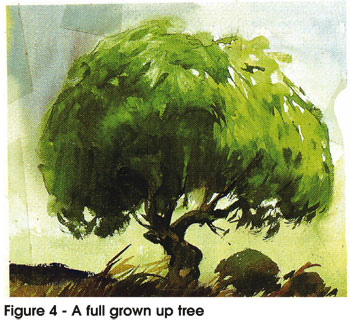|
Learn to draw by Tissa Hewavitarane:
Techniques for landscape
[Part 1]

When the surface is wet the paint spreads. On a dry surface, on the
contrary, brush strokes can be controlled. The two techniques facilitate
the realisation of different kinds of landscapes, although what is
important is to use the correct techniques at the right time and place.
If the two techniques are used together with a certain ability this
can pay dividends for the landscape painted. Watercolour on dry and wet
background can have many shapes in painting trees. They are easily
represented with a simple combination of shadowing.
A watercolour must always be painted from light to dark. After
outlining the area where the tree must go, a light green wash is
applied, and then the contrasts are put in. To start painting trees you
may start with the trunk or leaves.
To do the wash, dip the brush in water and load it well before
touching a little colour. Then pull it across the surface exercising
some pressure so that the water is released. Drain the brush and there
must not be too much water.
Use the wash to colour the area destined to be, the top of the tree.
The brush stroke has to be uniform and cover all the area. My first
illustration figure 1 demonstrate how to apply the first coating. Figure
2 shows the lightest colour being almost dry. The middle part is shaded
with a tone somewhat darker than the original. This is done with brush
strokes. The middle tones allow the highlights to be isolated. Finally
with dark brush strokes, the shadows are painted over the dry
background.
Figure 3 shows how a group of far off trees are painted. The process
is similar to the one explained at the beginning. The shades of the
first tone have to be together. The medium tones isolate over the dry
background paint in the shadow areas. Once the background tone has dried
different effects are realised to paint trees and reflections.

Finally figure 4 shows you how when a layer is applied on another
already dry layer, the result is the same of the two tones or colours
used.
The last illustration (Figure 4) is a full grown tree depicted with
huge foliage. The paper used to paint medium grain 250 gm paper, brushes
numbers 2, 3, 5 and 7 sable hair. Hookers agree and burnt amber is used
to paint the trunk. |

